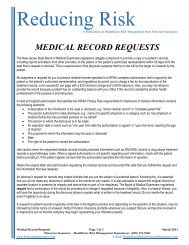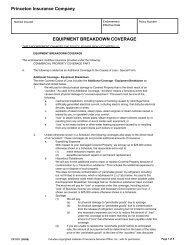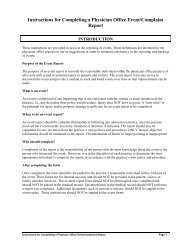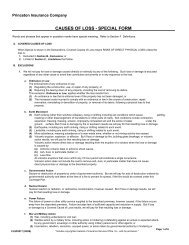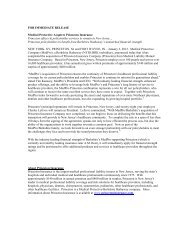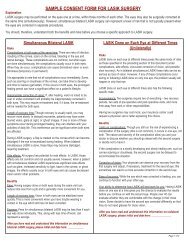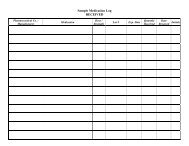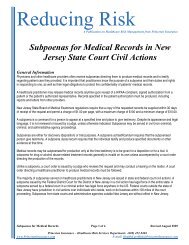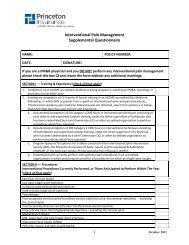Unexpected Medical Record Damage - Princeton Insurance
Unexpected Medical Record Damage - Princeton Insurance
Unexpected Medical Record Damage - Princeton Insurance
Create successful ePaper yourself
Turn your PDF publications into a flip-book with our unique Google optimized e-Paper software.
September 2011<br />
<strong>Unexpected</strong> <strong>Medical</strong> <strong>Record</strong> <strong>Damage</strong><br />
protecting your records when the water rushes in<br />
Accidents or unexpected disasters can result in extensive water damage to important documents such as medical records and X-<br />
ray films. In recent years, New Jersey has seen its share of flooding, including the most recent damage from Hurricane Irene and<br />
subsequent heavy rain. Broken water pipes or an overflowing floor drain can cause unexpected damage to stored medical records<br />
in a basement or storage room. Water damage can also be the often-unanticipated side effect of fire fighting efforts.<br />
When a practice faces a loss such as water damaged records and X-ray films, there are steps that should be taken:<br />
• Report the loss to your insurance carriers (general liability and property)<br />
• Check the records themselves<br />
• Are there some which are only partially destroyed and may be restored?<br />
• Are there records which are totally destroyed?<br />
Reporting to your carrier<br />
To facilitate any claim you make, you may wish to take pictures of the damage. A series of pictures over the period of clean-up<br />
may also be beneficial, especially when dealing with a loss suffered due to fire-related water damage.<br />
Keep a copy of the letter you send to your property carrier, and copies of the pictures, too. If you are named in a malpractice suit<br />
and asked to produce the records, this evidence will help respond to any allegations that records were negligently or willfully<br />
destroyed (spoliation).<br />
Partially destroyed records<br />
Moisture in any form and paper don’t mix; paper when exposed to water begins to deteriorate. The same process occurs with an<br />
X-ray film jacket but in a slower process. Moisture infiltrates the paper’s cell structure, followed by swelling and discoloration. An<br />
environment is then created that will permit the growth of mold and bacteria on the surface of the paper or X-ray film jacket. This<br />
can occur in a domino-like effect, spreading from folder to folder.<br />
Water-damaged medical records, film, and file jackets can be restored. The complete restoration of water-soaked documents can<br />
be an expensive process, yet it may be wise to attempt to salvage them. This process has to begin as quickly as possible, and a<br />
restoration company needs to be contacted. Since this company will be working with your patients’ records, you will need to have<br />
a HIPAA Business Associate agreement with them.<br />
The restoration company will place the materials into commercial freezers. Freezing, followed by vacuum freeze drying, has been<br />
shown to be one of the most effective methods of removing water from paper records and films. This is done to stop the process<br />
of deterioration or destruction. Once frozen, the materials are moved to a freeze-drying chamber. Air within the freeze drying<br />
chamber is removed through a vacuum process and the temperature lowered. The moisture within the materials is converted to a<br />
vapor state and then taken out of the chamber. The temperature within the freeze drying chamber is gradually increased over<br />
time, and any residue moisture is removed. Freeze-drying methods have been used in the recovery of books, manuscripts, leather,<br />
maps, historical and collectible items and textiles in the form of flags, needlework, silks and tapestries.<br />
If water damage has resulted from fire-fighting measures, cooperation with the fire marshal and health and safety officials is vital<br />
for a realistic appraisal of the feasibility of a safe salvage effort. Fire officers will decide when a building is safe to enter. In these<br />
instances, salvage operations are planned so that the environment of water-damaged areas can be stabilized and controlled both<br />
before and during the removal of the medical records and films. In warm weather, mold growth may be expected to appear within<br />
48 hours. Mold can also be expected to appear in poorly ventilated areas within the same time frame. It is therefore imperative to<br />
©2011, www.RiskReviewOnline.com – a publication of <strong>Princeton</strong> <strong>Insurance</strong> Company, <strong>Princeton</strong>, NJ 08540, Phone 800-334-0588 All rights reserved.<br />
While all materials presented herein are carefully researched, no warranty, guarantee or representation, either expressed or implied, is offered as to the accuracy<br />
of this information. <strong>Princeton</strong> <strong>Insurance</strong> and its employees are not engaged in rendering medical, or legal advice or service.
educe high humidity and temperature and vent the areas as soon as feasible. Water-soaked material must be kept as cool as<br />
possible with good air circulation. To leave such materials more than 48 hours in temperatures 70 degrees Fahrenheit or higher<br />
and a relative humidity above 60% without good circulation will certainly result in heavy mold growth and lead to a higher<br />
recovery/restoration cost.<br />
Completely destroyed records<br />
When records are completely destroyed, the challenge to the practice will be twofold. The destroyed records will need appropriate<br />
disposal, and new records will have to be constructed from information the practice can assemble.<br />
Destroying damaged records completely must be done to protect patient confidentiality and comply with HIPAA regulations. Dry<br />
the records and then shred them if possible. No intact record or X-ray may be discarded. As noted above, be aware of the<br />
likelihood that mold will develop. Lower humidity and ventilate the area where records are stored. When ready to destroy the<br />
records, the practice should keep a log of all records that are destroyed, as is done with planned record destruction. This log<br />
should include the following information:<br />
• name<br />
• date of birth<br />
• social security number<br />
• dates of first and last visit<br />
• general problems and procedures performed in the office<br />
• documentation of what was destroyed, how it was destroyed, and the date of destruction<br />
Reconstructing records can be done by pulling together information from other systems and files available to the practice. Patients<br />
should be notified of the flood event and the damage done to records. A history form can be sent to each patient along with this<br />
notification letter with a request that the patient complete this form to the best of their ability. A copy of this letter should be filed<br />
in the patient’s reconstructed medical record.<br />
Once each chart is rebuilt, there should be clear documentation explaining that it was reconstructed. This documentation should<br />
include at least the following:<br />
• date chart was reconstructed<br />
• reason for reconstruction<br />
• sources of information for reconstruction<br />
• efforts made to obtain other information (if applicable)<br />
• a statement that, due to reconstruction, the information contained in the chart as of the reconstruction date is considered<br />
inexact<br />
Medicare and the patients’ other insurance carriers may also expect to be notified that patient records have been lost. These<br />
organizations expect the practice to provide medical record documentation to support patient claims. When the medical record is<br />
destroyed they may want the practice to sign a form which attests to the unexpected loss of the record.<br />
Prevention<br />
It may feel like it’s too late to talk about preventing this sort of damage, but each hurricane or nor’easter produces calls from<br />
practices that had never flooded before and thought they were safe. Some had taken what they thought were appropriate<br />
precautions, only to find later they were not enough.<br />
It is appropriate to evaluate your storage space at least twice a year, though a quarterly examination would be even better. More<br />
frequent inspections are appropriate when weather is unusually harsh, no matter the season. Weather extremes expose the<br />
vulnerabilities of buildings much more quickly.<br />
Routine prevention steps should include stacking records and X-rays off the floor. Use shelving units, if possible, and position them<br />
as high off of the floor as possible. Keep in mind; however, that storing records too high can pose a potential injury concern for<br />
staff. A sturdy step stool may be needed to safely access these records. And, if you know the storm of the century is coming,<br />
take time to pull those lower boxes up out of the basement.
Finally, develop a system of routine record destruction so that you only keep the records you are supposed to keep. This will<br />
reduce the clutter in your storage area and reduce the number of records exposed to the risk of storm damage. You will find more<br />
information on routine record retention and destruction systems in the <strong>Princeton</strong> <strong>Insurance</strong> Office Practice Toolkit.<br />
In summary, each facility or physician/dental office should perform a risk and hazard vulnerability assessment and include<br />
document restoration as part of emergency preparedness and disaster planning.<br />
Ask your local emergency management office if your office is located in a known floodplain. Determine the elevation of your office<br />
in relation to local rivers, creeks, bays and the ocean. If your practice could be subject to flooding, medical records should be<br />
located at the highest level possible inside the office. Plastic tarps can be placed in rolls over the stored records and then unrolled<br />
when a storm approaches to protect against rain and roof damage. Take any paper out of the lower drawers of your desks and<br />
file cabinets and place them in plastic bags or plastic containers that can be placed on top of the units.<br />
Physicians who maintain paper records should also consider storing copies of their administrative records (financial, insurance,<br />
patient scheduling, patient lists) off-site in a secured area outside the floodplain area.<br />
For more helpful resources, visit: http://www.archives.gov/preservation/disaster-response/salvage-procedures.html.



